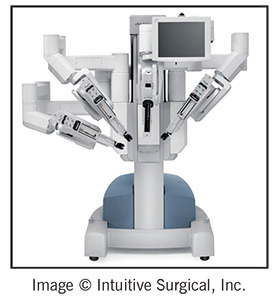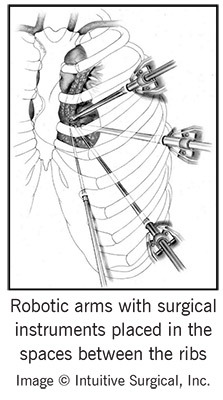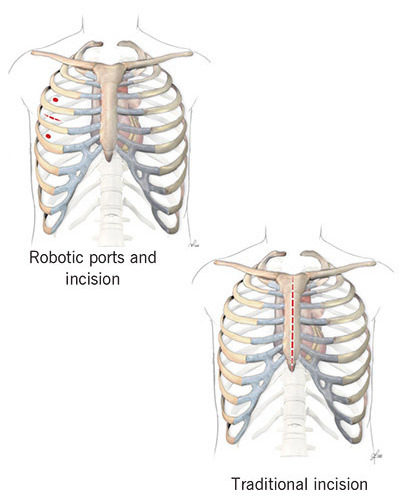What is robotically assisted heart surgery?
Robotically assisted heart surgery is a type of minimally invasive surgery performed by a cardiac surgeon. The surgeon uses a specially designed computer console to control surgical instruments on thin robotic arms.
Robotically assisted technology has changed the way certain heart operations can be performed. This technology allows surgeons to perform certain types of complex heart surgeries with smaller incisions and precise motion control, offering patients excellent outcomes. Cleveland Clinic offers robotically assisted heart surgery to treat a variety of cardiac conditions.
Robotic surgical system

Cleveland Clinic uses a state-of-the-art robotic surgical system approved by the FDA for use in performing many surgical procedures. The computer-enhanced robotic system consists of three components:
- A three-dimensional view of the surgical field, including depth of field, magnification and high resolution.
- Instruments on thin robotic arms that are designed to mimic the movement of the human hands, wrists and fingers, allowing an extensive range of motion and great precision.
- Master controls allow the surgeon to manipulate the instruments, translating the surgeon’s natural hand and wrist movements into corresponding precise and scaled movements.
How is robotically assisted surgery performed?

A small “working incision” and three small incisions (“ports”) are made in the spaces between the ribs. The surgical instruments (attached to the robotic arms) and a tiny camera with two lenses are placed through these ports. Motion sensors are attached to the robotic “wrist” so the surgeon can control the movement of the surgical instruments.
The surgeon sits at a computer console and looks through the two lenses (one for each eye) that display images from the camera inside the patient. The computer generates a clear, three-dimensional image of the surgical site for the surgeon to view. The surgeon can instantly zoom in and out to change the surgical view.
The surgeon’s hands control the movement and placement of the endoscopic instruments. The robotic “arm and wrist” movements mimic those of the surgeon. The surgeon is always in control during the surgery; there is no chance that the robotic arms will move on their own.
What are the benefits of robotically assisted surgery?
Compared with traditional surgery, the benefits of robotically assisted surgery may include:
- Small incisions with minimal scarring (see illustrations below).
- Short hospital stay (3 to 4 days).
- Low risk of bleeding or blood transfusion.
- Low risk of infection.
- Short recovery and quick return to daily and professional activities. The patient can resume normal activities and work as soon as he or she feels up to it; there are no specific activity restrictions after robotically assisted surgery.

Who is a candidate for this surgical technique?
To be considered for robotically assisted surgery, you will need diagnostic tests, including a chest X-ray and, in most cases, a cardiac catheterization. You may also need to have an echocardiogram and/or a computed tomography (CT) scan so the surgeon can learn more about your medical condition and determine if this is the best treatment option for you.
The type of treatment recommended for you depends on several factors, including the type and severity of heart disease you have and your age, medical history and lifestyle.
What surgeries can be performed using the robotic technique?
At Cleveland Clinic, selected patients can have robotically assisted surgery for:
- Mitral valve repair and replacement.
- Tricuspid valve repair and replacement.
- Combined mitral and tricuspid valve surgery.
- Atrial septal defect (ASD) repair.
- Patent foramen ovale (PFO) repair.
- Removal of cardiac tumors (myxomas) or pericardial cysts.
- Lead placement on the surface of the left ventricle during a biventricular pacemaker or defibrillator implant.
Robotically Assisted Techniques
Valve surgery
During traditional, open-chest surgeries, such as mitral and tricuspid valve surgery and bypass surgery, the surgeon makes a 6 to 8-inch incision through the sternum and spreads the ribs to see the heart and stop it from beating so the blood vessels can be stabilized. A heart-lung bypass machine is used to circulate the patient’s oxygenated blood during surgery.
During conventional minimally invasive surgery, the incision is about 3 to 4 inches.
The minimally invasive robotically assisted technique uses even smaller incisions — sometimes less than 2 inches. The surgeon’s hands control the movement and placement of the endoscopic instruments to open the pericardium (thin sac surrounding the heart) and to perform the procedure. In most cases, the sternum or breastbone does not need to be opened to perform the procedure.
ASD and PFO repair
Robotically assisted atrial septal defect (ASD) and patent foramen ovale (PFO) repair surgeries are performed through small incisions made in the right side of the chest. The surgeon’s hands control the movement and placement of the endoscopic instruments, which are used to retrieve a small patch of pericardial tissue. The tissue patch is used to repair the defect between the right and left atrium.
Removal of cardiac tumors
The most common benign tumor of the heart is a myxoma, which most frequently occurs in the left atrium. This type of tumor increases the risk of stroke. Removal of these tumors almost cures the problem and greatly reduces the risk of stroke. During the robotically assisted tumor removal procedure, the surgeon’s hands control the movement and placement of the endoscopic instruments through small incisions in the left atrium, and the instruments are used to remove the tumor.
Biventricular lead placement
During the robotically assisted biventricular pacemaker or defibrillator implant procedure, the surgeon’s hands control the movement and placement of the endoscopic instruments through small incisions in the chest wall. This surgical technique can be used to place leads on the surface of the left ventricle. The leads are then attached to the biventricular device (defibrillator or pacemaker) to "synchronize" the heartbeat and improve heart failure symptoms.
What are the risks of surgery?
As with any surgery, there are risks involved. Your surgical risks are related to your age, other medical conditions you have and the number of procedures performed during a single operation. Your doctor will discuss your personal risks before surgery; please ask questions to make sure you understand all of the potential risks.
Recovery after robotically assisted surgery
Your doctor will provide specific guidelines for your recovery and return to work, including specific instructions on activity and how to care for your incisions and general health after the surgery.
Most patients can resume normal activities, drive and return to work as soon as they feel up to it -- usually within 2 to 4 weeks after surgery.
To maintain your cardiovascular health after surgery, we strongly recommend making lifestyle changes and taking medications as prescribed.
Lifestyle changes include:
- Quitting smoking.
- Treating high cholesterol.
- Managing high blood pressure and diabetes.
- Exercising regularly.
- Maintaining a healthy weight.
- Eating a heart-healthy diet.
- Participating in a cardiac rehabilitation program, as recommended.
- Following up with your doctor for regular visits.
For more information
Contact: A.Marc Gillinov, M.D 216.445.8841
Visit the Robotic Surgery section of the Cleveland Clinic Heart & Vascular website at: clevelandclinic.org/heart
You may also call the Heart & Vascular Institute Resource Nurse at 216.445.9288 or toll-free at 866.289.6911.
Webmail and phone calls are answered 8:30 a.m. to 4:00 p.m. on regular business days.